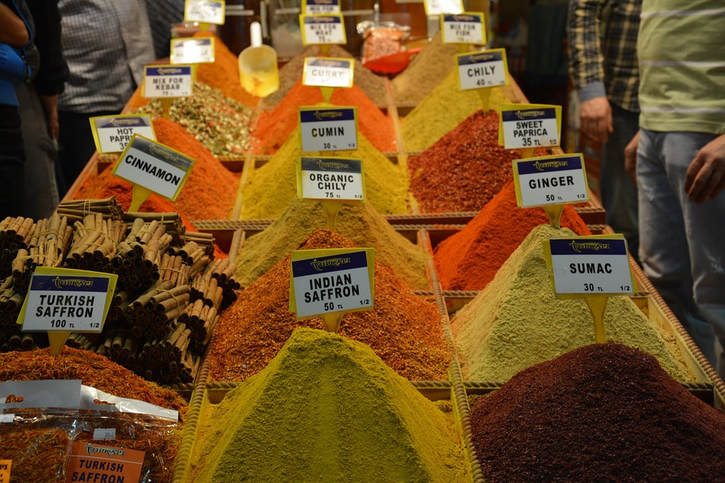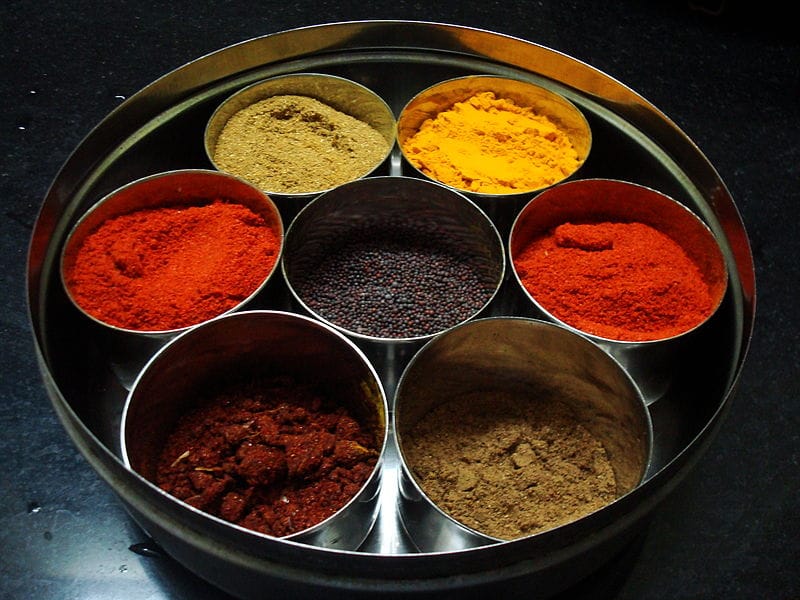USE RED / YELLOW SPICES TO HELP SOLVE INFLAMMATION
CURCUMIN / TUMERIC, BERBERE, CINNAMON, CURRY,
SAFFRON, GINGER, CUMIN, MUSTARD, BOSWELLIA……..

Some people might wonder why a person who deals almost exclusively with CHRONIC PAIN SYNDROMES would continue to beat the inflammation drum so loudly. In all honesty, it’s really not that difficult to understand. Inflammation is everything. EVERYTHING! Learn to control it and you will not only extend your life, your life will have less pain and distress (HERE). It’s easy to understand why, once you realize how many different health-related problems are caused by the group of immune system molecules we refer to collectively as “INFLAMMATION“.
The craziest thing is that not only is inflammation being driven by the CRAPPY DIETS eaten by most Americans, but it’s being driven by the drugs we take to compensate for said diets. For instance, SUGAR DRIVES BOTH INFECTION & DYSBIOSIS. But when we go to the doctor for either, we are given ANTIBIOTICS that cause the very problem(s) we are trying to correct. This is true of any number of drugs, including many NON-ANTIBIOTICS.
My goal is to see you get healthy, get to a normal weight, get off your drugs, GET OUT OF PAIN, and get your life back. It all starts with controlling inflammation. Not with NSAIDS or CORTICOSTEROIDS mind you, but with tangible lifestyle changes. Although EXERCISE is important, it is minimally so when compared to what you put in your mouth. WHAT YOU EAT is critical — critical for controlling inflammation and feeding a healthy (anti-inflammatory) MICROBIOME.
It’s one more reason why figuring out how to get more anti-inflammatory spices into your diet is important for all of us — especially if we are dealing with CHRONIC INFLAMMATORY DEGENERATIVE DISEASES, CHRONIC PAIN, AUTOIMMUNITY, a bad case of “THE LEAKIES,” or any number of others.
ANTI-INFLAMMATORY YELLOW SPICES

TUMERIC / CURCUMIN: Because it is arguably the most important of the lot, I am going to start with Tumeric (see pic at top and right). Related to ginger (we’ll get there), Tumeric is an Asian / Indian plant whose bright yellow roots are dried and powdered for use as a cooking spice (it is a major ingredient in curries). Many studies will, instead of referencing Tumeric (Curcuma Longa), talk about something called Curcumin, which is simply the part of Tumeric that gives it it’s distinctly yellow color.
According to a popular online encyclopedia, “Curcumin has been shown to inhibit certain epigenetic enzymes.” Why is this such a big deal? Because due to EPIGENETICS, you can no longer blame most of your health issues on your genes. Some of the ‘enzymes’ mentioned are responsible for seriously ugly diseases, while others are simply part of the enzymatic cascade of compounds that make up the inflammatory pathways.
As far as studies are concerned, if you go to PubMed and start looking at how much peer-reviewed (MAINSTREAM) research there is on Tumeric / Curcumin, you’ll be amazed. I’ve seen reputable sources say that there are nearly 7,000 studies touting the benefits of this yellow spice. These studies have made it into some doctor’s offices.
An email I received just yesterday from the Psychiatric Times carried a PDF Power Point presentation by expert on Bipolar Disorder, Dr. James Phelps (Curcumin: New Use for an Old Spice). Phelps stated that, “Accumulating evidence implicates inflammation as a critical mediator in the pathophysiology of mood disorders.”
That’s right folks, even Depression is considered to be “inflammatory” (HERE) along with any number of “psych” disorders. To see a list of health-related issues that have been helped by Curcumin / Tumeric, HERE it is (if the health problem is related to inflammation, I promise that someone somewhere has done or is currently doing research on it with Tumeric / Curcumin).
One more thing you need to understand about Tumeric / Curcumin is that by itself, it is not absorbed well. This means that you can eat lots and lots of top quality product and get little or no real health benefit, unless…… Just remember to use it with pepper (black pepper), as this simple spice will dramatically boost Tumeric’s bioavailability. Also remember that for those of you with NIGHTSHADE SENSITIVITIES, this could present a problem (Nightshades come into play with many of these other spices as well).
BERBERE: Unlike most of the others on this list, which are spices unto themselves, Berbere, like Curry, is a combination of any number of spices. Berbere includes Chili Peppers (and long peppers), Cumin, Garlic, Coriander, Ginger, Basil, Korarima, Rue, Ajwain, Radhuni, Nigella, and Fenugreek. Although I’m no expert on Berbere, I know a bit about some of the spices in this mixture. For instance, Fenugreek (the yellow seeds of a green leafy plant) is itself used to treat people with any number of inflammatory conditions, including DIABETES and ALLERGIES.
Berbere is a family favorite because of my ETHIOPIAN DAUGHTERS. After making two trips to Ethiopia a bit over five years ago, I came back with a love for Ethiopian food, which is seemingly all spiced up with Berbere, giving it a unique smell and taste.
The way that almost all Ethiopian food is eaten is by using Injera (a spongy sourdough pancake-like bread made from Teff — a GLUTEN FREE grain) to mop up the vegetable and meat dishes, which are often combined. If you’ve never tried Ethiopian cuisine, find a restaurant and go. Or better yet, make a friend with someone from Ethiopia (they are some of the most generous, genuine, and caring people I’ve ever been around) that might eventually be willing to cook you an authentic meal (you buy the food).
BOSWELLIA: If you’ve never had the chance to actually smell Boswellia, you are missing out. This is because the dried resin from the Boswellia Sacra tree goes by another name you may be more familiar with — Frankincense (recall that it was one of the three gifts that the “wise men” brought Christ). This herb is fairly scarce, mainly because the most quality product comes from a narrow geographical zone (the Nejd) that encompasses parts of Yemen, Oman, and Somalia, where the desert butts up to the Dhofar Mountains — an area known specifically for it’s fog.
The trees grow extremely slowly and as you might imagine, over-harvesting has become a problem. To the best of my knowledge, Boswellia is not used as a cooking spice. However, it is used for people dealing with the various inflammatory conditions mentioned via links, including a couple we haven’t mentioned by name — AUTOIMMUNE DISEASES and THE BIG “C”. The best product can be found at Standard Process’ sister company, Medi-Herb.
GINGER: Although fresh Ginger from the store is only slightly yellow, the dried form is much more so (the two have a somewhat different taste). As you can see, the root itself looks similar to Tumeric, and actually comes from the same family. Although renowned for its anti-inflammatory properties (especially arthritis), it’s commonly used for quieting an upset stomach.
For those of you who are interested, Ginger is the base of an anti-inflammatory drink (Green Tea & fresh Ginger, along with whatever else you want to add) that you can make yourself and keep in your fridge (HERE). You probably will not be surprised to learn that India and China are responsible for about half the worlds Ginger production.
CUMIN: Cumin, not to be confused with Caraway, which is itself yellow and sometimes called meridian fennel or Persian cumin, is another of the yellow spices that comes largely from India (most of the rest comes from regions near the Mediterranean — particularly the eastern portion). Cumin literally has dozens of reported health benefits, not surprisingly, most of which have to do with its anti-inflammatory properties. Cumin is a flavor you would recognize, as it is often used in chili powders and curries.
MUSTARD SEEDS: Although they come in many different colors, Mustard Seeds do come in yellow. Not only do the seeds have any number of anti-inflammatory qualities, mustard greens are considered to be one of the highest nutritional quality greens you can consume. BTW, much of what we today call ‘mustard’ (the condiment) used to be colored with Tumeric.
CINNAMON: Although it tends to be more brown than yellow, we are going to fudge a bit on this one. Cinnamon is one of the most incredible and healthful spices on the planet, with thousands of references in peer-reviewed journals. The spice itself comes from the rolled up bark of various kinds of Cinnamon trees, which are found mostly on island nations such as Sri Lanka, Madagascar, Indonesia, and the Seychelles.
Studies have shown that of all the spices we’ve mentioned thus far, Cinnamon has the highest antioxidant capacity. And in similar fashion to the other spices we’ve discussed today, Cinnamon has powerful anti-inflammatory properties as well, which means it can prove helpful when dealing with all sorts of health-related conditions (HERE is a list) as well as helping to lower LDL CHOLESTEROL.
It’s also been shown to be a powerful weapon in the war against DYSBIOSIS — particularly against YEASTS & FUNGUS. You could certainly add a bit of Cinnamon to the drink mentioned earlier, although I would absolutely not recommend that you consume Cinnamon in THIS MANNER, as it can be hazardous to your health.
The thing about all the spices discussed today (as well as any number I did not manage to get to) is that when used with common sense and moderation, you can’t really go wrong. They are spices for Pete’s sake, and have been used for millennia both for making food tastier as well as for medicinal purposes. However, if you are on certain drugs — particularly blood-thinners — ask your doctor.
Or maybe just go and check online as your doctor is not likely to know (HERE). The internet is full of great articles about the safety profiles of herbs and spices, finding the best sources for quality products, as well as recipes for using said spices, which can be a helpful part of THIS PROTOCOL. And like us on FACEBOOK if you appreciate what we are doing here.

One Response
Thank you for your wealth of fascia-health information, and thank you for providing it to everyone. I refer to your stuff again and again for myself and my family. Gold. Thank you.